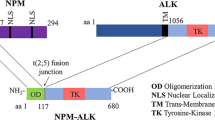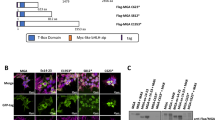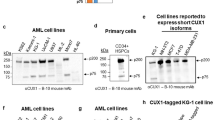Abstract
We analyzed the TS-2 acute lymphoblastic leukemia (ALL) cell line that contains a t(1;19)(q23;p13.3) but lacks E2A-PBX1 fusion typically present in leukemias with this translocation. We found that the t(1;19) in TS-2 fuses the 19p13 gene DAZAP1 (Deleted in Azoospermia-Associated Protein 1) to the 1q23 gene MEF2D (Myocyte Enhancer Factor 2D), leading to expression of reciprocal in-frame DAZAP1/MEF2D and MEF2D/DAZAP1 transcripts. MEF2D is a member of the MEF2 family of DNA binding proteins that activate transcription of genes involved in control of muscle cell differentiation, and signaling pathways that mediate response to mitogenic signals and survival of neurons and T-lymphocytes. DAZAP1 is a novel RNA binding protein expressed most abundantly in the testis. We demonstrate that MEF2D/DAZAP1 binds avidly and specifically to DNA in a manner indistinguishable from that of native MEF2D and is a substantially more potent transcriptional activator than MEF2D. We also show that DAZAP1/MEF2D is a sequence-specific RNA-binding protein. MEF2D has been identified as a candidate oncogene in murine retroviral insertional mutagenesis studies. Our data implicate MEF2D in human cancer and suggest that MEF2D/DAZAP1 and/or DAZAP1/MEF2D contribute to leukemogenesis by altering signaling pathways normally regulated by wild-type MEF2D and DAZAP1.
This is a preview of subscription content, access via your institution
Access options
Subscribe to this journal
Receive 12 print issues and online access
$259.00 per year
only $21.58 per issue
Buy this article
- Purchase on Springer Link
- Instant access to full article PDF
Prices may be subject to local taxes which are calculated during checkout





Similar content being viewed by others
References
Rabbitts TH . Chromosomal translocations in human cancer. Nature 1994; 372: 143–149.
Hunger SP . Chromosomal translocations involving the E2A gene in acute lymphoblastic leukemia: clinical features and molecular pathogenesis. Blood 1996; 87: 1211–1224.
Carroll AJ, Crist WM, Parmley RT, Roper M, Cooper MD, Finley WH . Pre-B cell leukemia associated with chromosome translocation 1;19. Blood 1984; 63: 721–724.
Michael PM, Levin MD, Garson OM . Translocation 1;19 – a new cytogenetic abnormality in acute lymphocytic leukemia. Cancer Genet Cytogenet 1984; 12: 333–341.
Mellentin JD, Murre C, Donlon TA, McCaw PS, Smith SD, Carroll AJ et al. The gene for enhancer binding proteins E12/E47 lies at the t(1;19) breakpoint in acute leukemias. Science 1989; 246: 379–382.
Nourse J, Mellentin JD, Galili N, Wilkinson J, Stanbridge E, Smith SD et al. Chromosomal translocation t(1;19) results in synthesis of a homeobox fusion mRNA that codes for a potential chimeric transcription factor. Cell 1990; 60: 535–545.
Kamps MP, Murre C, Sun XH, Baltimore D . A new homeobox gene contributes the DNA binding domain of the t(1;19) translocation protein in pre-B ALL. Cell 1990; 60: 547–555.
Hunger SP, Galili N, Carroll AJ, Crist WM, Link MP, Cleary ML . The t(1;19)(q23;p13) results in consistent fusion of E2A and PBX1 coding sequences in acute lymphoblastic leukemias. Blood 1991; 77: 687–693.
Kamps MP, Baltimore D . E2A-Pbx1, the t(1;19) translocation protein of human pre-B-cell acute lymphocytic leukemia, causes acute myeloid leukemia in mice. Mol Cell Biol 1993; 13: 351–357.
Dedera DA, Waller EK, LeBrun DP, Sen-Majumdar A, Stevens ME, Barsh GS et al. Chimeric homeobox gene E2A-PBX1 induces proliferation, apoptosis, and malignant lymphomas in transgenic mice [published erratum appears in Cell 1993 Nov 19;75(4):826]. Cell 1993; 74: 833–843.
Privitera E, Kamps MP, Hayashi Y, Inaba T, Shapiro LH, Raimondi SC et al. Different molecular consequences of the 1;19 chromosomal translocation in childhood B-cell precursor acute lymphoblastic leukemia. Blood 1992; 79: 1781–1788.
Yoshinari M, Imaizumi M, Eguchi M, Ogasawara M, Saito T, Suzuki H et al. Establishment of a novel cell line (TS-2) of pre-B acute lymphoblastic leukemia with a t(1;19) not involving the E2A gene. Cancer Genet Cytogenet 1998; 101: 95–102.
Breitbart RE, Liang CS, Smoot LB, Laheru DA, Mahdavi V, Nadal-Ginard B . A fourth human MEF2 transcription factor, hMEF2D, is an early marker of the myogenic lineage. Development 1993; 118: 1095–1106.
Martin JF, Miano JM, Hustad CM, Copeland NG, Jenkins NA, Olson EN . A Mef2 gene that generates a muscle-specific isoform via alternative mRNA splicing. Mol Cell Biol 1994; 14: 1647–1656.
McKinsey TA, Zhang CL, Olson EN . MEF2: a calcium-dependent regulator of cell division, differentiation and death. Trends Biochem Sci 2002; 27: 40–47.
Lund AH, Turner G, Trubetskoy A, Verhoeven E, Wientjens E, Hulsman D et al. Genome-wide retroviral insertional tagging of genes involved in cancer in Cdkn2a-deficient mice. Nat Genet 2002; 32: 160–165.
Suzuki T, Shen H, Akagi K, Morse HC, Malley JD, Naiman DQ et al. New genes involved in cancer identified by retroviral tagging. Nat Genet 2002; 32: 166–174.
Tsui S, Dai T, Roettger S, Schempp W, Salido EC, Yen PH . Identification of two novel proteins that interact with germ-cell-specific RNA-binding proteins DAZ and DAZL1. Genomics 2000; 65: 266–273.
Vera Y, Dai T, Hikim AP, Lue Y, Salido EC, Swerdloff RS et al. Deleted in azoospermia associated protein 1 shuttles between nucleus and cytoplasm during normal germ cell maturation. J Androl 2002; 23: 622–628.
Jack I, Seshadri R, Garson M, Michael P, Callen D, Zola H et al. RCH-ACV: a lymphoblastic leukemia cell line with chromosome translocation 1;19 and trisomy 8. Cancer Genet Cytogenet 1986; 19: 261–269.
Ashworth LK, Batzer MA, Brandriff B, Branscomb E, de Jong P, Garcia E et al. An integrated metric physical map of human chromosome 19. Nat Genet 1995; 11: 422–427.
Boomer T, Varella-Garcia M, McGavran L, Meltesen L, Olsen AS, Hunger SP . Detection of E2A translocations in leukemias via fluorescence in situ hybridization. Leukemia 2001; 15: 95–102.
Maloney KW, McGavran L, Murphy JM, Odom LF, Stork L, Wei Q et al. TEL-AML1 fusion identifies a subset of children with standard risk acute lymphoblastic leukemia who have an excellent prognosis when treated with therapy that includes a single delayed intensification. Leukemia 1999; 13: 1708–1712.
Hunger SP, Ohyashiki K, Toyama K, Cleary ML . Hlf, a novel hepatic bZIP protein, shows altered DNA-binding properties following fusion to E2A in t(17;19) acute lymphoblastic leukemia. Genes Dev 1992; 6: 1608–1620.
Hunger SP, Brown R, Cleary ML . DNA-binding and transcriptional regulatory properties of hepatic leukemia factor (HLF) and the t(17;19) acute lymphoblastic leukemia chimera E2A-HLF. Mol Cell Biol 1994; 14: 5986–5996.
Hunger SP, Li S, Fall MZ, Naumovski L, Cleary ML . The proto-oncogene HLF and the related basic leucine zipper protein TEF display highly similar DNA-binding and transcriptional regulatory properties. Blood 1996; 87: 4607–4617.
McCombie WR, Heiner C, Kelley JM, Fitzgerald MG, Gocayne JD . Rapid and reliable fluorescent cycle sequencing of double-stranded templates. DNA Seq 1992; 2: 289–296.
Shore P, Sharrocks AD . The MADS-box family of transcription factors. Eur J Biochem 1995; 229: 1–13.
Black BL, Olson EN . Transcriptional control of muscle development by myocyte enhancer factor-2 (MEF2) proteins. Annu Rev Cell Dev Biol 1998; 14: 167–196.
Inaba T, Roberts WM, Shapiro LH, Jolly KW, Raimondi SC, Smith SD et al. Fusion of the leucine zipper gene HLF to the E2A gene in human acute B-lineage leukemia. Science 1992; 257: 531–534.
Wan L, Kim JK, Pollard VW, Dreyfuss G . Mutational definition of RNA-binding and protein–protein interaction domains of heterogeneous nuclear RNP C1. J Biol Chem 2001; 276: 7681–7688.
Sun L, Youn HD, Loh C, Stolow M, He W, Liu JO . Cabin 1, a negative regulator for calcineurin signaling in T lymphocytes. Immunity 1998; 8: 703–711.
Youn HD, Sun L, Prywes R, Liu JO . Apoptosis of T cells mediated by Ca2+-induced release of the transcription factor MEF2. Science 1999; 286: 790–793.
Youn HD, Chatila TA, Liu JO . Integration of calcineurin and MEF2 signals by the coactivator p300 during T-cell apoptosis. EMBO J 2000; 19: 4323–4331.
Youn HD, Grozinger CM, Liu JO . Calcium regulates transcriptional repression of myocyte enhancer factor 2 by histone deacetylase 4. J Biol Chem 2000; 275: 22563–22567.
Bour BA, O'Brien MA, Lockwood WL, Goldstein ES, Bodmer R, Taghert PH et al. Drosophila MEF2, a transcription factor that is essential for myogenesis. Genes Dev 1995; 9: 730–741.
Lilly B, Zhao B, Ranganayakulu G, Paterson BM, Schulz RA, Olson EN . Requirement of MADS domain transcription factor D-MEF2 for muscle formation in Drosophila. Science 1995; 267: 688–693.
Lin Q, Schwarz J, Bucana C, Olson EN . Control of mouse cardiac morphogenesis and myogenesis by transcription factor MEF2C. Science 1997; 276: 1404–1407.
Mao Z, Bonni A, Xia F, Nadal-Vicens M, Greenberg ME . Neuronal activity-dependent cell survival mediated by transcription factor MEF2. Science 1999; 286: 785–790.
Woronicz JD, Lina A, Calnan BJ, Szychowski S, Cheng L, Winoto A . Regulation of the Nur77 orphan steroid receptor in activation-induced apoptosis. Mol Cell Biol 1995; 15: 6364–6376.
Okamoto S, Li Z, Ju C, Scholzke MN, Mathews E, Cui J et al. Dominant-interfering forms of MEF2 generated by caspase cleavage contribute to NMDA-induced neuronal apoptosis. Proc Natl Acad Sci USA 2002; 99: 3974–3979.
Han TH, Prywes R . Regulatory role of MEF2D in serum induction of the c-jun promoter. Mol Cell Biol 1995; 15: 2907–2915.
Pan F, Ye Z, Cheng L, Liu JO . Myocyte enhancer factor 2 mediates calcium-dependent transcription of the interleukin-2 gene in T lymphocytes: a calcium signaling module that is distinct from but collaborates with the nuclear factor of activated T cells (NFAT). J Biol Chem 2004; 279: 14477–14480.
Nagai K, Oubridge C, Ito N, Avis J, Evans P . The RNP domain: a sequence-specific RNA-binding domain involved in processing and transport of RNA. Trends Biochem Sci 1995; 20: 235–240.
Delattre O, Zucman J, Plougastel B, Desmaze C, Melot T, Peter M et al. Gene fusion with an ETS DNA-binding domain caused by chromosome translocation in human tumours. Nature 1992; 359: 162–165.
Ron D . TLS-CHOP and the role of RNA-binding proteins in oncogenic transformation. Curr Top Microbiol Immunol 1997; 220: 131–142.
Mercher T, Coniat MB, Monni R, Mauchauffe M, Khac FN, Gressin L et al. Involvement of a human gene related to the Drosophila spen gene in the recurrent t(1;22) translocation of acute megakaryocytic leukemia. Proc Natl Acad Sci USA 2001; 98: 5776–5779.
Barbouti A, Hoglund M, Johansson B, Lassen C, Nilsson PG, Hagemeijer A et al. A novel gene, MSI2, encoding a putative RNA-binding protein is recurrently rearranged at disease progression of chronic myeloid leukemia and forms a fusion gene with HOXA9 as a result of the cryptic t(7;17)(p15;q23). Cancer Res 2003; 63: 1202–1206.
Miyamoto K, Tomita N, Ishii A, Nonaka H, Kondo T, Tanaka T et al. Chromosome abnormalities of leukemia cells in adult patients with T-cell leukemia. J Natl Cancer Inst 1984; 73: 353–362.
Vagner-Capodano AM, Mozziconacci MJ, Zattara-Cannoni H, Guitard AM, Thuret I, Michel G . t(1;19) in a M4-ANLL [letter]. Cancer Genet Cytogenet 1994; 73: 86–88.
Wlodarska I, Stul M, De Wolf-Peeters C, Verhoef G, Mecucci C, Cassiman JJ et al. t(1;19) without detectable E2A rearrangements in two t(14;18)-positive lymphoma/leukemia cases [see comments]. Genes Chromosomes Cancer 1994; 10: 171–176.
Yuki Y, Imoto I, Imaizumi M, Hibi S, Kaneko Y, Amagasa T et al. Identification of a novel fusion gene in a pre-B acute lymphoblastic leukemia with t(1;19)(q23;p13). Cancer Sci 2004; 95: 503–507.
Acknowledgements
We thank Anne Olsen for supplying cosmids and BACs, Pauline Yen for the DAZAP1 cDNA, Ron Prywes for the p4xMEF2FLuc reporter construct, Amanda Rice and Chuhua Zhong for technical advice and assistance. This work was supported by grants from the Loewenstern Family Foundation and Monfort Family Foundation to SPH, NCI Cancer Center Core Grant CA 46934, and by the grants from the Leukemia Research Foundation and the Cancer League of Colorado to LG.
Author information
Authors and Affiliations
Corresponding author
Additional information
Supplementary Information
Supplementary Information accompanies the paper on the Leukemia website (http://www.nature.com/leu).
Rights and permissions
About this article
Cite this article
Prima, V., Gore, L., Caires, A. et al. Cloning and functional characterization of MEF2D/DAZAP1 and DAZAP1/MEF2D fusion proteins created by a variant t(1;19)(q23;p13.3) in acute lymphoblastic leukemia. Leukemia 19, 806–813 (2005). https://doi.org/10.1038/sj.leu.2403684
Received:
Accepted:
Published:
Issue Date:
DOI: https://doi.org/10.1038/sj.leu.2403684
Keywords
This article is cited by
-
DAZAP1 overexpression promotes growth of HCC cell lines: a primary study using CEUS
Clinical and Translational Oncology (2022)
-
Cytogenetic Characteristics of Childhood Acute Lymphoblastic Leukemia: A Study of 1541 Chinese Patients Newly Diagnosed between 2001 and 2014
Current Medical Science (2022)
-
Emerging molecular subtypes and therapeutic targets in B-cell precursor acute lymphoblastic leukemia
Frontiers of Medicine (2021)
-
Myocyte enhancer factor 2D provides a cross-talk between chronic inflammation and lung cancer
Journal of Translational Medicine (2017)
-
Myocyte enhancer factor 2D promotes tumorigenicity in malignant glioma cells
Tumor Biology (2016)



